Land Invertebrates
Media
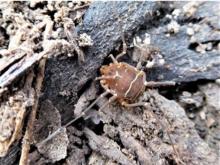
Species Types
Scientific Name
Members of suborder Laniatores
Description
Armored harvestmen have spines on their fingerlike mouthparts (pedipalps). Unlike other harvestmen, members of this suborder of so-called daddy longlegs do not usually have long legs.
Media

Species Types
Scientific Name
Megarhyssa atrata
Description
The female black giant ichneumon wasp deposits her eggs through wood. The larvae eat the grubs of wood-boring insects.
Media
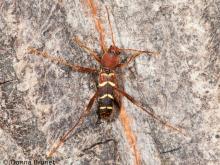
Species Types
Scientific Name
Neoclytus acuminatus
Description
Red-headed ash borers resemble wasps, but they are harmless to people. The colors and markings are distinctive. Their larvae feed on a variety of dead or dying hardwoods, helping the decomposition process and enriching the soil.
Media
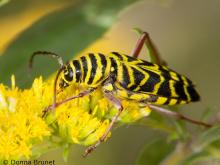
Species Types
Scientific Name
Megacyllene robiniae
Description
The locust borer is a longhorned beetle whose larvae tunnel into the trunks of black locust. The colorful black and yellow adults are often seen in late summer as they feed on the pollen of goldenrod and other flowers.
Media

Species Types
Scientific Name
About 2,000 species in North America north of Mexico
Description
Plant bugs, or mirids, are a huge family of true bugs. They are often overlooked — except by gardeners and farmers. Most mirids eat plants, and some are agricultural pests. As a group, they’re an important food source for birds and other insectivores.
Media
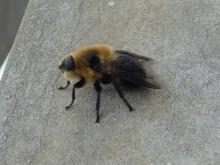
Species Types
Scientific Name
About 40 species in North America north of Mexico
Description
Bot flies are chunky, beelike flies usually with rounded heads. Adults are not commonly seen. The larvae are short, pudgy, segmented grubs that live as parasites in the tissues of animals. Those that live just under the skin often form a bulge. Some types live in the nasal or throat cavities of deer.
Media
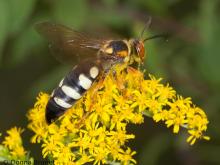
Species Types
Scientific Name
Stizus brevipennis
Description
The eastern stizus is a large, solitary wasp that is often misidentified as the better-known eastern cicada-killer wasp. The markings are slightly different, however, and the eastern stizus female hunts katydids, not cicadas.
Media

Species Types
Scientific Name
About 1,300 species in North America north of Mexico
Description
The longlegged flies are a large, diverse fly family. They often have eye-catching metallic green, copper, bronze, or blue bodies and long legs. Their delicate wings are often clear and look iridescent in bright light, but many species have dark marks near the wing tips.
Media
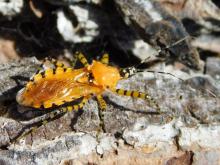
Species Types
Scientific Name
Pselliopus barberi
Description
The orange assassin bug, Pselliopus barberi, is about ½ inch long and is one of our most attractive non-butterfly insects. They overwinter in groups as adults under loose bark.
Media

Species Types
Scientific Name
Vespa crabro
Description
The European hornet is a large, nonnative hornet that was introduced to New York in the mid-1800s. They now occur across most of the eastern United States, including Missouri. People may misidentify them as the highly publicized, so-called murder hornets.
See Also



Media

Species Types
Scientific Name
Cisseps fulvicollis
Description
The yellow-collared scape moth is more often “orange-collared.” And whether you think it looks more like a firefly or a wasp, it’s still a moth!
Media

Species Types
Scientific Name
Nearly 150 species in North America north of Mexico
Description
Slim, delicate plume moths are instantly recognizable by their T-shaped silhouette, long legs, and muted shades of tan and brown. It can be hard to separate the various species.
Media

Species Types
Scientific Name
Pyrrharctia isabella
Description
Not many people know the adult Isabella tiger moth when they see one, but we’re all acquainted with its caterpillar, the woolly worm, or woolly bear.
About Land Invertebrates in Missouri
Invertebrates are animals without backbones, including earthworms, slugs, snails, and arthropods. Arthropods—invertebrates with “jointed legs” — are a group of invertebrates that includes crayfish, shrimp, millipedes, centipedes, mites, spiders, and insects. There may be as many as 10 million species of insects alive on earth today, and they probably constitute more than 90 percent all animal species.





















